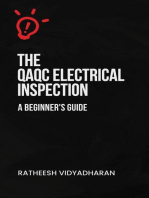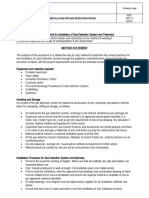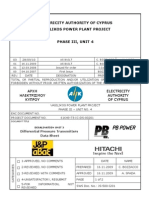Method Statement Loop Check
Method Statement Loop Check
Uploaded by
Mohamed RafihCopyright:
Available Formats
Method Statement Loop Check
Method Statement Loop Check
Uploaded by
Mohamed RafihOriginal Description:
Copyright
Available Formats
Share this document
Did you find this document useful?
Is this content inappropriate?
Copyright:
Available Formats
Method Statement Loop Check
Method Statement Loop Check
Uploaded by
Mohamed RafihCopyright:
Available Formats
METHOD STATEMENT
FOR
INSTRUMENT LOOP CHECKING
1. LOOP TEST PROCEDURE OF EACH INSTRUMENT
a. Pressure Transmitter Loop:
Verify the installation as per hookup and also the bench calibration report.
Verify the cable termination as per the inter connection drawing and for cable megger reports.
Execute the continuity check.
Check and verify the PLC Configuration for applicable points.
Power on circuit and verify the Transmitter Tag No. and range is as per latest Data sheet, by
using HART communicator.
Apply the pressure for Digital Smart Transmitters by using test equipment (hand pump) 0, 25,
50, 75 and 100% of the instrument range simulation to check the transmitter response at PLC.
Confirm / verify the corresponding reading in the PLC / Integral indicator and at remote
indicator if applicable.
For smart transmitters case (HART) communicator shall be used for simulation purpose instead
of hand pump.
For Foundation Field bus case (FF) communicator shall be used for simulation purpose instead
of hand pump.
For Non- smart transmitters case (loop simulator i.e. 4~20 mA) source to be used for simulation
purpose instead of hand pump.
Alarms function (in PLC) shall be checked by Simulating /Verifying the required signal.
b. Level Transmitter Loop (GWR TYPE):
Verify the installation as per hookup.
Verify the cable termination as per the inter connection drawing and for cable megger reports.
Execute the continuity check.
Check and verify the PLC Configuration for applicable points.
Power on circuit and verify the transmitter range is as per latest Data sheet.
The tank is made emptied. The value of 0% is set by excluding the offset value from the bottom
of the tank. The value is set by using either the HART Communicator or at the Level
Transmitter. For Level Transmitter with Foundation Field bus FF Communicator is used.
The value of 100% is set by HART communicator or at the Level Transmitter when the tank is
fully filled. The value is set by using either the HART Communicator or at the Level
Transmitter. For Level Transmitter with Foundation Field bus FF Communicator is used.
For smart transmitters case (HART) communicator shall be used for simulation purpose.
For Foundation Field bus case (FF) communicator shall be used for simulation purpose.
c. Flow Transmitter Loop (Magnetic Flow Meter):
Verify the installation as per hookup and also the bench calibration report.
Verify the cable termination as per the inter connection drawing and for cable megger reports.
Execute the continuity check.
Check and verify the PLC Configuration for applicable points.
Power on circuit and verify the transmitter range is as per latest Data sheet, by using HART
communicator.
For smart transmitters case (HART) communicator shall be used for simulation purpose instead
of hand pump.
For Foundation Field bus case (FF) communicator shall be used for simulation purpose instead
of hand pump.
For Non- smart transmitters case (loop simulator i.e. 4~20 mA) source to be used for simulation
purpose instead of hand pump.
Alarms function (in PLC) shall be checked by Simulating /Verifying the required signal.
.
d. Switches Loops (Pressure Switches/Level Switches):
Check and verify the PLC configuration for applicable points.
Simulate the contact operation (Make/Break) at the switch terminal block and verify the status
in the PLC.
Pressure switches shall be checked by applying set point pressure using Habd Pump.
Level switches shall be checked by operating the float mechanism.
e. Gas Detector/ Beacon/Horn
Check and verify the PLC configuration for applicable points.
Precede the calibration of gas detector by introducing the applicable gas for H2S and LEL.
Apply the magnet for 0% and verify the status at gas detector display/PLC.
Apply 50% and 100% to gas detector and verify the status at gas detector display /PLC.
Check the Beacon status at high alarm condition.
Check the Horn status at high alarm condition.
f. Interface Loops:
MCC loops shall be executed after motor solo run test.
Check and verify the PLC configuration for applicable points.
Remove the control transformer primary and secondary fuses for the applicable cubicle.
Apply 120 VAC power (external power from building outlet) on the secondary fuses load side to
energize the control circuit.
Apply the Command from PLC Field for start, stop or trip as applicable.
Verify the running / stop or trip status in PLC / Field / Sub Station as applicable.
Check and verify the local / remote switch function if applicable.
After completion of the applicable loop check, the fuses should be returned on the control
transformer.
All the above-mentioned steps can be carried out without removing the pad lock on the MCC
unit breakers, if possible.
Removal of the lock on the breakers requires permission from Electrical section.
g. Miscellaneous Instrument:
Verify the installation as per hookup and also the bench calibration report.
Verify the cable termination as per the inter connection drawing and for cable megger reports.
Execute the continuity check.
Check and verify the PLC Configuration for applicable points.
Power on circuit and verify the Transmitter Tag No. and range is as per latest Data sheet, by
using HART communicator.
For smart transmitters case (HART) communicator shall be used for simulation purpose instead
of hand pump.
For Foundation Field bus case (FF) communicator shall be used for simulation purpose instead
of hand pump.
For Non- smart transmitters case (loop simulator i.e. 4~20 mA) source to be used for simulation
purpose instead of hand pump.
Alarms shall be checked by Simulating /Verifying the required signal.
On successful completion of loop test, Loop check sheet shall be signed by QC Inspector ,
SAPID,SAPMT, and other concerned parties.
2. EQUIPMENT AND TOOLS
HART FIELDBUS COMMUNICATOR.
DIGITAL MULTIMITTER
HYDRAULIC HAND PUMP.
PNEUMATIC HAND PUMP.
LOOP CALIBRATOR.
CLAMP METER
CURRENT LOOP SIMULATOR
ELECTRIC / INSTRUMENT HAND TOOLS.
You might also like
- Loop Check PresentationDocument39 pagesLoop Check Presentationsaqib javaid100% (9)
- Instrument Loop Testing Procedure-1Document9 pagesInstrument Loop Testing Procedure-1Susanto Pausinugroho75% (4)
- QAQC Electrical Inspection: A Beginner's GuideFrom EverandQAQC Electrical Inspection: A Beginner's GuideRating: 4.5 out of 5 stars4.5/5 (2)
- Method Statement For Gas Detection System and Telemetry SystemDocument2 pagesMethod Statement For Gas Detection System and Telemetry Systemvictor100% (1)
- Loop Test Sheet PDFDocument1 pageLoop Test Sheet PDFTrí NguyễnNo ratings yet
- Loop Check Procedure PDFDocument8 pagesLoop Check Procedure PDFImran Nawaz Mehthal80% (5)
- Pressure Transmitter SOPDocument2 pagesPressure Transmitter SOPambesh100% (2)
- Loop Check Sheet TransmitterDocument2 pagesLoop Check Sheet Transmittershanks26380% (5)
- Instrument Commissioning ChecklistDocument13 pagesInstrument Commissioning Checklistrajeshkumarab100% (12)
- 4.itp For Instrumentation & ControlDocument10 pages4.itp For Instrumentation & ControlJoel Alcantara75% (4)
- Chap 1Document32 pagesChap 1안혜영No ratings yet
- I&C Inspection and Test Plan - NWC Dhurma Pump Station, Pp11, Pp12, Pp13Document16 pagesI&C Inspection and Test Plan - NWC Dhurma Pump Station, Pp11, Pp12, Pp13Mohd Sami Uddin100% (1)
- Loop Test Procedure of Each InstrumentDocument2 pagesLoop Test Procedure of Each InstrumentMohamed Rafih100% (2)
- Icl 009 PLC PanelDocument2 pagesIcl 009 PLC Panelsamwel kariukiNo ratings yet
- Instrumentation General Procedure-InstallationDocument23 pagesInstrumentation General Procedure-InstallationDewAngga Yudistira100% (8)
- Method Statement - FinalDocument6 pagesMethod Statement - FinalJustin Joy0% (1)
- Testing and Commissioning of Motor Control Center Method StatementDocument3 pagesTesting and Commissioning of Motor Control Center Method StatementHumaid Shaikh75% (4)
- 001-072 MX9859 2014 Catalog Vol2Document72 pages001-072 MX9859 2014 Catalog Vol2IsraelMolinaNo ratings yet
- Loop Checking Basic ProcedureDocument4 pagesLoop Checking Basic ProcedureHamada Elsharawy100% (1)
- Conduct Loop TestDocument19 pagesConduct Loop Testkoangyak100% (2)
- Loop Test ProcedureDocument4 pagesLoop Test Procedureviddyadrian100% (2)
- Defining The Loop: - 20 Ma DC Is Coming From DCS or JB Want To Check. ThatDocument3 pagesDefining The Loop: - 20 Ma DC Is Coming From DCS or JB Want To Check. ThatNazeer Ahamad KhanNo ratings yet
- Flow & Level Calibration Notes: Differential Pressure Transmitter CalibrationDocument9 pagesFlow & Level Calibration Notes: Differential Pressure Transmitter Calibrationterio16100% (1)
- Instr Loop CheckDocument3 pagesInstr Loop CheckMiko Quijano100% (1)
- Control Valve Calibration FFDocument3 pagesControl Valve Calibration FFKram Alim Villon100% (1)
- Loop Checking and Field Instrument Testing ProcedureDocument7 pagesLoop Checking and Field Instrument Testing Procedurecharzree0% (1)
- Loop Check Sheet Sol ValveDocument2 pagesLoop Check Sheet Sol Valveshanks263100% (1)
- Field Instrument Install ProcedureDocument13 pagesField Instrument Install ProcedureAnonymous waSxJGoNo ratings yet
- Saudi Aramco Test Report: 30.apr.13 Inst SATR-J-6501 Instrument Loop - Inputs - Transmitter Circuit TestDocument4 pagesSaudi Aramco Test Report: 30.apr.13 Inst SATR-J-6501 Instrument Loop - Inputs - Transmitter Circuit TestRashid Arshad100% (1)
- How To Do Loop Checks During Plant Pre-CommissioningDocument18 pagesHow To Do Loop Checks During Plant Pre-Commissioningtom2626100% (1)
- Form No. 102 - Control ValveDocument2 pagesForm No. 102 - Control ValveVictor Nair100% (1)
- Loop Checking Procedure IdeasDocument2 pagesLoop Checking Procedure IdeasJonatas13No ratings yet
- P-5000T - Loop Folder PDFDocument15 pagesP-5000T - Loop Folder PDFSrikant SuruNo ratings yet
- Instrument Loop Check Sheet: DCS/Local Indicator & Visual CheckDocument1 pageInstrument Loop Check Sheet: DCS/Local Indicator & Visual CheckMohd A IshakNo ratings yet
- Instrumentation TestingDocument24 pagesInstrumentation Testingaugur886No ratings yet
- Loop Test Procedure 71259C-0100-PP-941 - OpenDocument40 pagesLoop Test Procedure 71259C-0100-PP-941 - Opensaid250009250No ratings yet
- (EMERSON) Loop CheckingDocument29 pages(EMERSON) Loop CheckingDavid Chagas83% (6)
- Loop Cheking ProcedureDocument5 pagesLoop Cheking ProcedureMd Omar Faruque100% (3)
- I11c Instrument Close Loop Check PG 1Document1 pageI11c Instrument Close Loop Check PG 1Momo ItachiNo ratings yet
- DPT Calibration FFDocument4 pagesDPT Calibration FFKram Alim VillonNo ratings yet
- Loop Check and ValveDocument1 pageLoop Check and ValveMohd A Ishak100% (1)
- D002 (I&C) Instrument and Calibration Procedure For Turbine & Boiler AreaDocument38 pagesD002 (I&C) Instrument and Calibration Procedure For Turbine & Boiler AreaSurya Darma100% (1)
- Section 25 50 52 - INSTRUMENT CALIBRATION AND COMMISSIONINGDocument13 pagesSection 25 50 52 - INSTRUMENT CALIBRATION AND COMMISSIONINGAhmad DagamsehNo ratings yet
- Chapter 38 Instrument Installation and Commissioning 2010 Instrumentation Reference Book Fourth EditionDocument6 pagesChapter 38 Instrument Installation and Commissioning 2010 Instrumentation Reference Book Fourth EditionMotasim_mNo ratings yet
- Check List For Installation of Local Instruments.Document1 pageCheck List For Installation of Local Instruments.Jaya Seelan100% (1)
- Commissioning of A PLCDocument10 pagesCommissioning of A PLCTahir DonNo ratings yet
- DP Level Transmitter CalibrationDocument4 pagesDP Level Transmitter CalibrationSijo Joy100% (3)
- FAT Procedure-FGI Kakinada Rev-1Document13 pagesFAT Procedure-FGI Kakinada Rev-1vsrikala68100% (1)
- SATR-J-6501 - Rev 0 PDFDocument5 pagesSATR-J-6501 - Rev 0 PDFAdel KlkNo ratings yet
- Instrument Check List PDFDocument9 pagesInstrument Check List PDFIgor PaivaNo ratings yet
- Instrumentation Switch ChecklistDocument9 pagesInstrumentation Switch Checklistgeorge stanley paceteNo ratings yet
- ITP For Instrumentation ControlDocument9 pagesITP For Instrumentation Controlsugeng wahyudiNo ratings yet
- Construction Leak Test ProcedureDocument9 pagesConstruction Leak Test Procedurezack zeeart100% (1)
- JMS For INSTRUMENT TUBING AND IMPULSE LINE Pressure Leak TestDocument3 pagesJMS For INSTRUMENT TUBING AND IMPULSE LINE Pressure Leak Testzack zeeartNo ratings yet
- Instrumentation Job Interview Preparation GuideDocument11 pagesInstrumentation Job Interview Preparation GuideJignesh Banava100% (1)
- Instrumentation Interview QuestionDocument35 pagesInstrumentation Interview Questionabbutalibb100% (2)
- Instrument Calibration ChecklistDocument11 pagesInstrument Calibration ChecklistMohd A IshakNo ratings yet
- 9.9 Differential Pressure TransmittersDocument99 pages9.9 Differential Pressure TransmittersorazioconiglioNo ratings yet
- Method Statement For Configuration of The TTP Substations in Scada in The RCCDocument27 pagesMethod Statement For Configuration of The TTP Substations in Scada in The RCCjasonhucetNo ratings yet
- Cold Loop CheckingDocument1 pageCold Loop CheckingZulkernain Omer TariqNo ratings yet
- K S RF M 805 T: Otron Mart Odel RansmitterDocument16 pagesK S RF M 805 T: Otron Mart Odel RansmitterGerman ToledoNo ratings yet
- Section 12b - Microwave Network Field ATPDocument11 pagesSection 12b - Microwave Network Field ATPAdeyemi_o_olugbileNo ratings yet
- Statement of Account: Date Narration Chq./Ref - No. Value DT Withdrawal Amt. Deposit Amt. Closing BalanceDocument3 pagesStatement of Account: Date Narration Chq./Ref - No. Value DT Withdrawal Amt. Deposit Amt. Closing BalanceMohamed RafihNo ratings yet
- Statement of Account: Date Narration Chq./Ref - No. Value DT Withdrawal Amt. Deposit Amt. Closing BalanceDocument5 pagesStatement of Account: Date Narration Chq./Ref - No. Value DT Withdrawal Amt. Deposit Amt. Closing BalanceMohamed RafihNo ratings yet
- UG B.A. EnglishDocument224 pagesUG B.A. EnglishMohamed RafihNo ratings yet
- Dde CalendaryearDocument4 pagesDde CalendaryearMohamed RafihNo ratings yet
- Statement of Account: Date Narration Chq./Ref - No. Value DT Withdrawal Amt. Deposit Amt. Closing BalanceDocument13 pagesStatement of Account: Date Narration Chq./Ref - No. Value DT Withdrawal Amt. Deposit Amt. Closing BalanceMohamed RafihNo ratings yet
- X10D Installation Practices Using 91B Series Cable: Training Course - ND3361Document7 pagesX10D Installation Practices Using 91B Series Cable: Training Course - ND3361Mohamed RafihNo ratings yet
- August 15 2012 TickDocument2 pagesAugust 15 2012 TickMohamed RafihNo ratings yet
- Account Statement From 1 Apr 2020 To 31 Mar 2021: TXN Date Value Date Description Ref No./Cheque No. Debit Credit BalanceDocument3 pagesAccount Statement From 1 Apr 2020 To 31 Mar 2021: TXN Date Value Date Description Ref No./Cheque No. Debit Credit BalanceMohamed RafihNo ratings yet
- Nd3361 Patchmax Termadv Jan11Document11 pagesNd3361 Patchmax Termadv Jan11Mohamed RafihNo ratings yet
- Eclipse Model 706 High Performance Guided Wave Radar Level TransmitterDocument44 pagesEclipse Model 706 High Performance Guided Wave Radar Level TransmitterMohamed RafihNo ratings yet
- StanchionDocument1 pageStanchionMohamed RafihNo ratings yet
- Tables and ResponsibilitiesDocument6 pagesTables and ResponsibilitiesMohamed RafihNo ratings yet
- Flame Ionization Detector (FID) PrincipleDocument2 pagesFlame Ionization Detector (FID) PrincipleMohamed RafihNo ratings yet
- Return Ticket PDFDocument1 pageReturn Ticket PDFMohamed RafihNo ratings yet
- Nd3361 Mps100e Termadv Jan11Document9 pagesNd3361 Mps100e Termadv Jan11Mohamed RafihNo ratings yet
- Nd3361 Mgs400 Termadv Jan11Document10 pagesNd3361 Mgs400 Termadv Jan11Mohamed RafihNo ratings yet
- Nd3361 Hgs620 Termadv Jun12Document10 pagesNd3361 Hgs620 Termadv Jun12Mohamed RafihNo ratings yet
- Nd3361 Ipatch Termadv Jan12Document7 pagesNd3361 Ipatch Termadv Jan12Mohamed RafihNo ratings yet
- Nd3361 1100gs Termadv Aug11Document14 pagesNd3361 1100gs Termadv Aug11Mohamed RafihNo ratings yet
- Fiber Budget Loss Calculation SheetDocument11 pagesFiber Budget Loss Calculation SheetMohamed RafihNo ratings yet
- Nd3361 91b Cable Preparation Termadv Jan11Document5 pagesNd3361 91b Cable Preparation Termadv Jan11Mohamed RafihNo ratings yet
- Fiber Optic Master File Rev 2Document44 pagesFiber Optic Master File Rev 2Mohamed RafihNo ratings yet
- Sro TicketDocument1 pageSro TicketMohamed RafihNo ratings yet
- DOC-01-031 - AFP-3030 Installation Manual (AUS) Rev ADocument52 pagesDOC-01-031 - AFP-3030 Installation Manual (AUS) Rev AMohamed RafihNo ratings yet
- Subaru Impreza WRX 08-13 ManualDocument408 pagesSubaru Impreza WRX 08-13 Manualnicholas adhytia riantoNo ratings yet
- Cardiac EmergenciesDocument38 pagesCardiac Emergenciesnurasia oktianiNo ratings yet
- Doctors Sheet DelhiDocument10 pagesDoctors Sheet DelhistupidgyeNo ratings yet
- Peças Rolo Compactador SEM 8218 8220 8222Document158 pagesPeças Rolo Compactador SEM 8218 8220 8222BliblibloNo ratings yet
- Plastic Solar Cell SumanDocument20 pagesPlastic Solar Cell SumanRaj KhanNo ratings yet
- Annex A Report On The Utilization of FY 2019 Sangguniang Kabataan SK FundsDocument4 pagesAnnex A Report On The Utilization of FY 2019 Sangguniang Kabataan SK FundsAbarra MichelleNo ratings yet
- Negative Induct AnceDocument7 pagesNegative Induct Ancekarim_ouakliNo ratings yet
- ss4 Instructions PDFDocument7 pagesss4 Instructions PDFIanDubhNo ratings yet
- Inline Blending New LogoDocument6 pagesInline Blending New LogoMuhammad Darussalam HerdaniNo ratings yet
- RMTUTORIALSDocument10 pagesRMTUTORIALSAnyasi UcheNo ratings yet
- Tabatabai1969 PDFDocument7 pagesTabatabai1969 PDFWidiaTifaniNo ratings yet
- Gamlen CA1Document2 pagesGamlen CA1dansco.autoNo ratings yet
- Bangalore UrbnDocument12 pagesBangalore UrbnRajshekar AeNo ratings yet
- RN ResumeDocument2 pagesRN Resumeapi-519736590No ratings yet
- Contraceptive Comparison ChartDocument1 pageContraceptive Comparison ChartdryasirsaeedNo ratings yet
- Cleric Arcadia HelpDocument3 pagesCleric Arcadia HelpLeón Delgado GómezNo ratings yet
- Rate Chart PanchakarmaDocument2 pagesRate Chart PanchakarmayogasanaNo ratings yet
- ASSAB Tool Steel Performance Chart A4 enDocument2 pagesASSAB Tool Steel Performance Chart A4 en6310520% (1)
- The Knee and The Cruciate Ligaments Anatomy Biomechanics Clinical Aspects Reconstruction Complications Rehabilitation by H.-U. Stäubli, R. P. Jakob (Auth.), Prof. Dr. R. P. Jakob, PD Dr. H.-U. StäuDocument633 pagesThe Knee and The Cruciate Ligaments Anatomy Biomechanics Clinical Aspects Reconstruction Complications Rehabilitation by H.-U. Stäubli, R. P. Jakob (Auth.), Prof. Dr. R. P. Jakob, PD Dr. H.-U. StäuemilNo ratings yet
- Qualitative AnalysisDocument3 pagesQualitative AnalysisYukeling TayNo ratings yet
- 4 0 Hydrates Wax Asphaltenes and Chemical InjectionDocument30 pages4 0 Hydrates Wax Asphaltenes and Chemical InjectionPham LanphuongNo ratings yet
- Quality Solutions: ISO 9001: 2015 Quality Management SystemDocument9 pagesQuality Solutions: ISO 9001: 2015 Quality Management SystemOsman AitaNo ratings yet
- Role of Food Processing in Food and Nutrition Security PDFDocument11 pagesRole of Food Processing in Food and Nutrition Security PDFAugusto Manrique100% (1)
- SPE-193038-MS Pioneering Rigless Perforating, Clean-Up Operation, Well Testing With MPLT and Bottom Hole Sampling in Remote PlatformDocument8 pagesSPE-193038-MS Pioneering Rigless Perforating, Clean-Up Operation, Well Testing With MPLT and Bottom Hole Sampling in Remote PlatformTheNourEldenNo ratings yet
- Kalmar Medium Electric Forklift Brochure PDFDocument13 pagesKalmar Medium Electric Forklift Brochure PDFMarc Biosca SierraNo ratings yet
- Manual de Operacion Ep Es14-30wa (Pds30) Es18-40wa (Pds40) 20120806Document34 pagesManual de Operacion Ep Es14-30wa (Pds30) Es18-40wa (Pds40) 20120806Ricardo Gamez OrtegaNo ratings yet
- Pharmaceutical Microbiology Unit 3Document45 pagesPharmaceutical Microbiology Unit 3Karan PathakNo ratings yet
- Com.5257 Manuale MR-B 8K Igbt EngDocument50 pagesCom.5257 Manuale MR-B 8K Igbt Engjesse.carvalhoNo ratings yet

















































































































